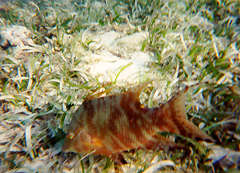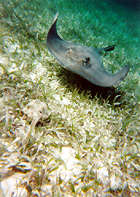|
| 
Seagrass Beds: A Valuable EcosystemPreviously, we covered the importance of mangrove and coral reef ecosystems. In the region between mangroves and the coral reef exists an ecosystem of great ecological value: seagrass beds. This week, Reef Brief will explore this habitat, one that is seldom given the attention or protection it deserves. Looking out at the sea, the turquoise water is scattered with dark patches, which are mostly comprised of seagrass beds. When a friend of mine was visiting, she noticed these patches and wondered why the seagrass wasn't simply eliminated so that there would be a more aesthetically pleasing, uniform, sandy sea floor. What my friend didn't understand is that seagrass, like almost everything found in the marine environment, plays many important roles.
 Currently, there are several threats facing sea grass beds. Due to the fact that seagrass productivity is highly dependent on a number of factors, such as salinity, water temperature, and turbidity, this ecosystem is particularly sensitive to degradation due to agricultural, industrial, and domestic pollution. With increased agricultural activity, a major threat to seagrass is run-off of herbicides. The exact toxic effect of this run-off is still unknown, but it's safe to assume there is a substantial negative impact. Additionally, the effluent from reverse osmosis plants has a high salinity that can alter the composition of surrounding water, thus hindering seagrass productivity. Of immediate concern in Ambergris Caye, however, is the dredging activity currently taking place. Sand extraction and deposition not only destroys seagrass beds directly, but may also indirectly effect future seagrass productivity by increasing turbidity and deposition of sediments.
If you have a topic that you would like to have featured in Reef Brief, please contact Green Reef at 2833 This Reef Brief was written by Ann Hayden.
|
 Copyright by Casado Internet Group, Belize |
 With root like stems, which extend horizontally under the sea bottom, seagrasses act to stabilize the sediment. These sediments, that would otherwise settle on coral and prevent contact with sunlight, tend to accumulate and become trapped in the seagrass. Turtle grass, the most common type of seagrass in Belize, thrives in areas that are protected from wind-driven current and surf. The broad leaves of turtle grass act as huge filters, removing particles from the water and depositing them as fine sediment. These sediments often contain organic matter which contribute to the high productivity of this habitat.
With root like stems, which extend horizontally under the sea bottom, seagrasses act to stabilize the sediment. These sediments, that would otherwise settle on coral and prevent contact with sunlight, tend to accumulate and become trapped in the seagrass. Turtle grass, the most common type of seagrass in Belize, thrives in areas that are protected from wind-driven current and surf. The broad leaves of turtle grass act as huge filters, removing particles from the water and depositing them as fine sediment. These sediments often contain organic matter which contribute to the high productivity of this habitat. As of yet, there is no specific legislation protecting seagrasses, although generally the Fisheries Department is responsible for this habitat. Green Reef recommends that in addition to controlling the use of pesticides and decreasing run-off, dredging activities need to be strictly monitored and limited. Seagrass beds should be thought of an indication of the health of the ecosystem; when they begin to disappear, we know there's trouble.
As of yet, there is no specific legislation protecting seagrasses, although generally the Fisheries Department is responsible for this habitat. Green Reef recommends that in addition to controlling the use of pesticides and decreasing run-off, dredging activities need to be strictly monitored and limited. Seagrass beds should be thought of an indication of the health of the ecosystem; when they begin to disappear, we know there's trouble.